List of urban areas in the Nordic countries
This is a list of urban areas in the Nordic countries by population. The population is measured on a national level, independently by each statistical bureau. Statistics Sweden uses the term tätort (urban settlement), Statistics Finland uses also tätort in Swedish and taajama in Finnish, Statistics Denmark uses byområde (city), while Statistics Norway uses tettsted (urban settlement). Despite an older statistical definition was agreed upon in the Nordic countries[1] a continuous built-up area whose population is at least 200 inhabitants and where the maximum distance between residences is 200 metres; discounting roads, parking spaces, parks, sports grounds and cemeteries – without regard to the ward, municipal or county boundaries.[1][2], the actual boundaries are not set by the statistical bureaus. Any scientific comparing isn't possible.
List
| Rank | City / urban settlement | Urban area | Metropolitan | Notes | Image |
|---|---|---|---|---|---|
| 1 | 1,515,017 | 2,269,060[3] | Capital of Sweden. Municipality: 932,917. The Stockholm urban area, Urban Stockholm, or Tätorten Stockholm as it is called in Swedish, consists of the municipalities of Stockholm, Solna and Sundbyberg, as well as parts of Botkyrka, Danderyd, Haninge, Huddinge, Järfälla, Nacka, Sollentuna, Tyresö municipalities. The metropolitan area is called Metropolitan Stockholm or Stor-Stockholm. Only "Innerstan", parts of Solna, Liljeholmen and the area around Stockholm Globe Arena can be described as city core, rather than suburb. | 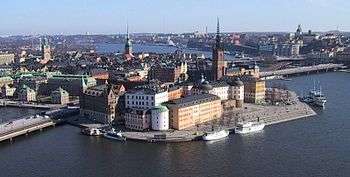 | |
| 2 | 1,308,893[4] | 2,350,000[5][6] | Capital of Denmark. Municipality: 613,288 Statistics Denmark considers the City of Copenhagen (Byen København) to consist of the Municipality of Copenhagen plus three adjacent municipalities, viz. Dragør, Frederiksberg, and Tårnby.[7] Their combined population stands at 775,033 (as of January 2018).[8] The Urban area of Copenhagen (Hovedstadsområdet) is defined as the municipalities of Copenhagen, Frederiksberg, Albertslund, Brøndby, Gentofte, Gladsaxe, Glostrup, Herlev, Hvidovre, Lyngby-Taarbæk, Rødovre, Tårnby and Vallensbæk, as well as parts of the Ballerup, Rudersdal, Furesø, Ishøj and Greve municipalities. The Copenhagen metropolitan area (Hovedstadsregionen) had a population of 2.6 million in 2018, while the Oresund Region had approximately 4 million. Copenhagen city core (including block build-up areas only) comprises most of the municipality's area but also includes entire Frederiksberg as well as good parts of Gentofte (Hellerup and Ordrup districts) and Tårnby (areas north of Copenhagen Airport). | ||
| 3 | 1,268,296[9] | 1,360,232 | Capital of Finland. Municipality: 632,577. Urban Helsinki, or Helsingin kaupunkialue as it is called in Finnish, is defined by Statistics Finland. At minimum it includes most of the neighbouring municipalities Espoo, Vantaa and Kauniainen. For the Greater Helsinki area: 1,360,232. The city's core is located at a peninsula and is around the same size as Oslo's. | ||
| 4 | 942,084[10] | 1,588,457[11][12] | Capital of Norway. Municipality: 647,676. The very large area known as the Greater Oslo Region (metropolitan) area has a population of 1,546,706. Conurbation includes the neighbouring municipalities Bærum, Asker, Skedsmo, Lørenskog and Oppegård in their entirety, as well as parts of Røyken, Sørum, Nittedal, Rælingen and Ski. It is the fastest growing capital city in Europe.[13] The city's block up-built core is small. | ||
| 5 | 581,822 | 997,446[3] | Municipality: 581,822. For the official statistical entity see Storgöteborg (Gothenburg Metropolitan Area). |  | |
| 6 | 334,112[9] | 370,084 | Municipality: 217,767. Eurostats population size for Tampere is 369,525.[14] | 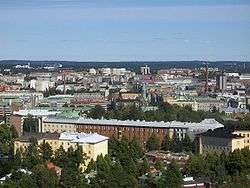 | |
| 7 | 301,706 | 707,120[3] Approximately 1 million for all municipalities bordering Öresund's Swedish shores, and municipalities bordering to such a shore-municipality. | Municipality: 328,494. For the official statistical entity Stormalmö (Malmö Metropolitan Area): 707,120 and for the Oresund Region circa 3,900,000[15] | 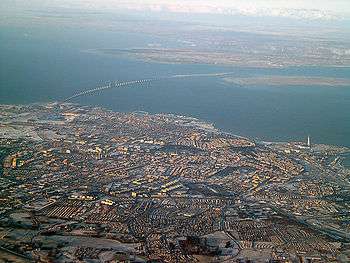 | |
| 8 | 273,077[16] | Municipality: 340,421.[17] Which is a part of the East Jylland region with a population of 1,279,492. Eurostats population size for Aarhus is 845,971.[14] |  | ||
| 9 | 272,230[9] | 315,751[18] | Municipality: 180,546. |  | |
| 10 | 247,731[10] | 420,000 | Municipality: 267,150. Metropolitan area: 377,116. |  | |
| 11 | 203,771[10] | 319,822 | Municipality: 128,830. Metropolitan area: 297,569.
Conurbation includes the neighbouring municipalities Sandnes, Randaberg and Sola. |
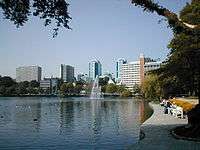 | |
| 12 | 212,385 | 212,385[19] | Capital of Iceland. Municipality: 118,898. Metropolitan area includes the neighbouring municipalities Kópavogur, Hafnarfjörður, Garðabær, Mosfellsbær, Seltjarnarnes and Álftanes.[19] Note, no urban area is defined. | ||
| 13 | 200,400[9] | Municipality: 191,237 | 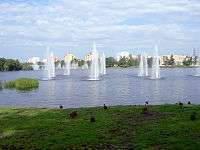 | ||
| 14 | 178,210[20] | Municipality: 213,558 | |||
| 15 | 169,972[10] | Municipality: 180,280. Metropolitan area: 274,958. | 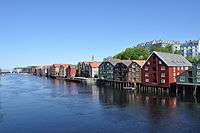 | ||
| 16 | 140,454 | 253,704[21] | Municipality: 197,787 |  | |
| 17 | 134,672[20] | Includes Nørresundby; Municipality: 205,809 | |||
| 18 | 123,241[9] | Municipality: 134,756 | 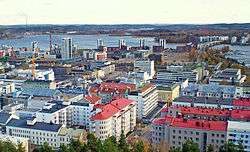 | ||
| 19 | 119,068[9] | Municipality: 103,187 | |||
| 20 | 110,877 | 173,322[21] | Municipality: 137,207 | 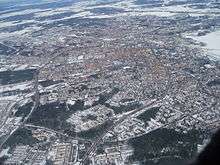 | |
| 21 | 110,503[10] | Includes the neighbouring municipality Nedre Eiker in its entirety, as well as parts of Øvre Eiker, Lier and Røyken. | 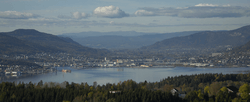 | ||
| 22 | 107,038 | 208,241[21] | Municipality: 135,460 | 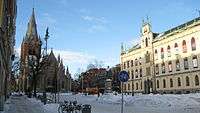 | |
| 23 | 106,758[10] | Fredrikstad with 61,264 inhabitants and Sarpsborg with 44,281 have grown together, to form an urban area known as "Nedre Glommaregionen" (the Lower Glomma Region – The cities are placed along the outlet of the river Glomma, hence the name). | |||
| 24 | 104,232 | 177,308[21] | Municipality: 146,416 |  | |
| 25 | 97,122 | 272,873[21] | Municipality: 129,177 | 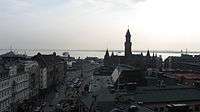 | |
| 26 | 90,621[10] | Includes the neighbouring municipalities of Porsgrunn and Skien in its entirety, as well as a part of Bamble. | 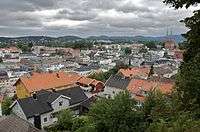 | ||
| 27 | 89,396 | Municipality: 127,382 | |||
| 28 | 88,520[9] | 167,753[21] | Municipality: 105,229 | 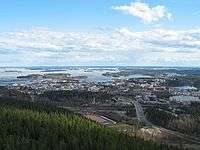 | |
| 29 | 87,247 | 183,100[21] | Municipality: 130,050 | 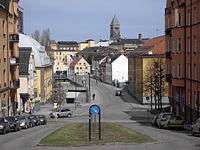 | |
| 30 | 84,190[9] | Municipality: 83,473 | 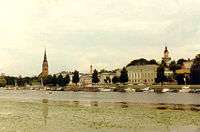 | ||
| 31 | 82,800 | Municipality: 110,488
No metro area, part of Malmö/Lund/Trelleborg metro region[21] |
 | ||
| 32 | 79,594 | Municipality: 115,473 | |||
| 33 | 72,398 | Municipality: 116,032 |  | ||
| 34 | 71,033 | 184,346[21] | Municipality: 95,055 | ||
| 35 | 67,811[9] | Municipality: 74,457 | 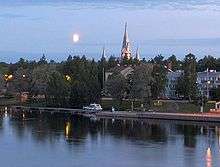 | ||
| 36 | 67,690[9] | Municipality: 66,401 |  | ||
| 37 | 66,273 | Municipality: 103,294 |  | ||
| 38 | 64,679 | 209,028[21] | Municipality: 96,311 |  | |
| 39 | 64,619 | - | Municipality: 86,246
No independent area, part of Greater Stockholm[21] |
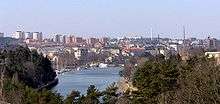 | |
| 40 | 62,687 | Municipality: 98,265 | 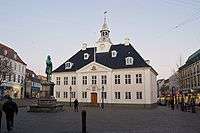 | ||
| 41 | 61,685 | 179,486[21] | Municipality: 85,753 | 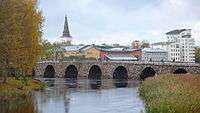 | |
| 42 | 61,272 | - | Municipality: 63,789
No independent area, part of Greater Stockholm |
_2009.jpg) | |
| 43 | 60,887 | 156.629[21] | Municipality: 83,005 | 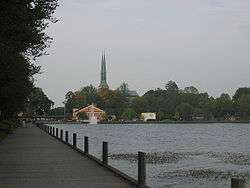 | |
| 44 | 58,662[10] | Municipality: 88,320 | 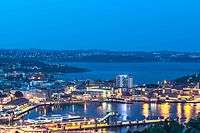 | ||
| 45 | 60,508 | Municipality: 92,515 | 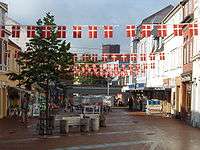 | ||
| 46 | 58,577 | 134,156[21] | Municipality: 91,800 | ||
| 47 | 56,567 | Municipality: 114,140 |  | ||
| 48 | 55,884 | Municipality: 85,662 | 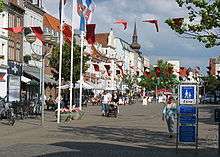 | ||
| 49 | 55,743[9] | Municipality: 72,748 |  | ||
| 50 | 52,753[9] | Municipality: 61,166 | 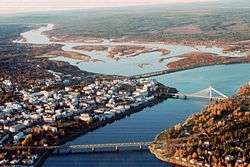 | ||
| 51 | 51,704[9] | Municipality: 54,845 |  | ||
| 52 | 50,712 | 125,812[21] | Municipality: 96,977 |  |
Note that the population numbers from the different countries are from different years, as Statistics Finland, Statistics Norway and Statistics Denmark release the statistic yearly (albeit at different times of the year), Statistics Sweden only release the figures every five years. The Norwegian data is from 2013,[10] the Danish data is from 2014,[22] the Swedish is from 2010[23] and the Finnish is from 2012.[9]
Also note that some of the statistics have been updated since the first note was made, so some statistics may be from 2018, while others from 2013, etc.
See also
- Largest metropolitan areas in the Nordic countries
- List of the most populated municipalities in the Nordic countries
- List of metropolitan areas in Sweden
- List of urban areas in Sweden by population
- List of urban areas in Denmark by population
- List of urban areas in Norway by population
- List of urban areas in Finland by population
- List of cities in Iceland
- List of cities in the Baltic states
- List of metropolitan areas by population
References
- 1 2 "Nationalencyklopedin - Tätort". Nationalencyklopedin. Retrieved 21 July 2014.
Translation: 'a for the Nordic countries shared statistical definition of built-up area with at least 200 residents, not more than 200 m between each other (without regard to the ward, municipal or county boundaries)'
- ↑ "Localities 2010: Population, age and gender" (PDF) (in Swedish and English). Statistics Sweden. Retrieved 21 July 2014.
A densely built area includes any cluster of buildings with at least 200 inhabitants, unless the distance between the houses exceeds 200 metres. However, the distance may exceed 200 metres if the cluster of buildings is situated within the area of influence of a larger locality. [...] Even if the distance between buildings exceeds 200 metres, the locality should not be divided if the area between the buildings is used for public purposes such as roads, parking spaces, parks, sports grounds and cemeteries. The same applies to undeveloped areas such as storage sites, railways and docks.page=21
- 1 2 3 "http://www.statistikdatabasen.scb.se/pxweb/sv/ssd/START__BE__BE0101__BE0101A/BefolkningNy/table/tableViewLayout1/?rxid=0e262c9f-0788-4ea1-ab40-8aefe74cc13d". www.statistikdatabasen.scb.se. Retrieved 2017-12-22. External link in
|title=(help) - ↑ http://www.statistikbanken.dk (BY1)
- ↑ OECD: Territorial Review Copenhagen, 2009, p. 34, ISBN 9789264060029
- ↑ also obtainable through
- ↑ "Regioner, landsdele og kommuner. v 1.0: 2007- - Danmarks Statistik". Dst.dk. Retrieved 2018-07-18.
- ↑ "The average Dane". www.dst.dk.
- 1 2 3 4 5 6 7 8 9 10 11 12 13 14 Urban settlements by population and population density, 31 Dec 2017
- 1 2 3 4 5 6 7 8 9 Citypopulation Norway Archived 2012-11-20 at the Wayback Machine.
- ↑ regionaldepartementet, Kommunal- og (2003-05-09). "St.meld. nr. 31 (2002-2003)". Regjeringen.no (in Norwegian). Retrieved 2017-12-22.
- ↑ "Folketalet ved nyttår var 5 258 000". ssb.no (in Norwegian Nynorsk). Retrieved 2017-12-22.
- ↑ Savage, Maddy (18 July 2018). "Oslo's rapid growth redefines Nordic identity" – via www.bbc.com.
- 1 2 http://appsso.eurostat.ec.europa.eu/nui/show.do?dataset=urb_lpop1&lang=en
- ↑ "Befolkning – Øresundsinstituttet". www.oresundsinstituttet.org.
- ↑ "Statistikbanken". www.statbank.dk.
- ↑ "Statistikbanken". www.statistikbanken.dk.
- ↑ "Seutukuntien ennakkoväkiluku alueittain, elokuu 2013". Tiedote (in Finnish). Statistics Finland (Tilastokeskus). 2013-08-31. Retrieved 2 October 2013.
- 1 2 "http://px.hagstofa.is/pxen/pxweb/en/Ibuar/Ibuar__mannfjoldi__2_byggdir__Byggdakjarnar/MAN03105.px/table/tableViewLayout1/?rxid=0dc32c15-8460-40a0-84d6-5c1685055aba". px.hagstofa.is. Retrieved 2017-12-22. External link in
|title=(help) - 1 2 "Population 1. January by urban, rural areas (DISCONTINUED) - StatBank Denmark - data and statistics". www.statistikbanken.dk.
- 1 2 3 4 5 6 7 8 9 10 11 12 13 14 15 16 "table". www.statistikdatabasen.scb.se. Retrieved 2017-12-22.
- ↑ "Denmark: Regions, Municipalities, Cities and Urban Areas - Population Statistics in Maps and Charts". www.citypopulation.de.
- ↑ "Sweden: Counties, Cities, Municipalities, Settlements and Metropolitan Areas - Population Statistics in Maps and Charts". www.citypopulation.de.